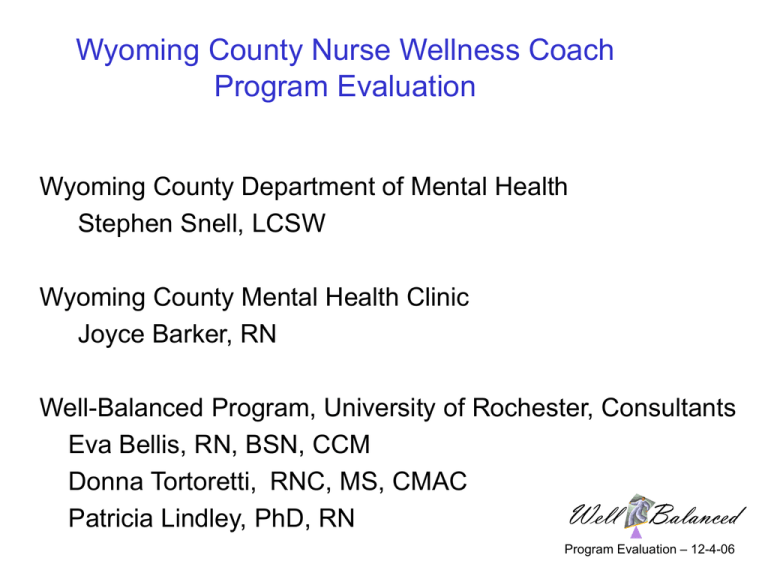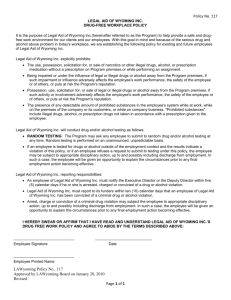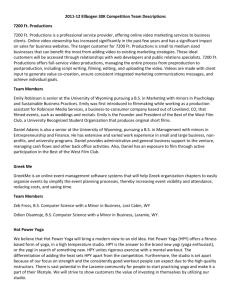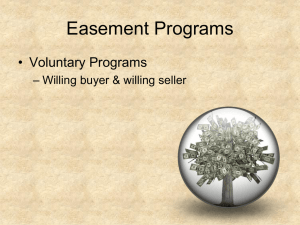Link to Power Point Presentation
advertisement

Wyoming County Nurse Wellness Coach Program Evaluation Wyoming County Department of Mental Health Stephen Snell, LCSW Wyoming County Mental Health Clinic Joyce Barker, RN Well-Balanced Program, University of Rochester, Consultants Eva Bellis, RN, BSN, CCM Donna Tortoretti, RNC, MS, CMAC Patricia Lindley, PhD, RN Program Evaluation – 12-4-06 Program Design: 2006 “Embedded” nurse wellness coach (clinic employee) works in tandem with mental health clinicians and care coordinators on clientdetermined physical health issues Caseload: 20 slots, revolving enrollment, attends SPOA Not time limited; pace/frequency of contacts vary Eligibility: Care coordination enrollees with moderate to high risk physical health problems, by referral Program dovetails with Monroe’s Well Balanced Program, using same assessment, documentation and planning tools Not disease-specific: interventions customized to individual health problems, client wishes, capacities and readiness Maximize internet, disease-management protocols “best practices” for education Program Evaluation – 12-4-06 Assessment and Enrollment Client interview Comprehensive Health Risk Assessment (HRA) yields numerical score and suggested areas for intervention (see sample) Home visit Laboratory Program Evaluation – 12-4-06 2006 Client Participation – 20 client caseload Referred and Assessed Total N=32 Did not enroll •3/6 completed HRA Dropped Out Enrolled, completed HRA, bloodwork and individualized plan N=26 n = 6; n=7 •Decided to pursue on own 1 •Moved out of county 2 •To nursing home 1 •Client chose not to pursue 3 Completed Pre-toPost Analysis: N=15 10+ direct contacts plus all tests and information Program Evaluation – 12-4-06 Client Demographics Age of Clients Upon Enrollment M SD Range Wyoming County N = 15 Monroe County N = 77 48 9.61 32 – 69 years 46 9.56 22 – 64 years Program Evaluation – 12-4-06 Client Demographics Characteristics Gender Female Male Race African American Caucasian Hispanic/Latino Asian Native American Wyoming County N = 15 n % Monroe County N = 77 n % 13 87% 2 13% 52 25 68% 32% 0 15 100% 0 0 0 27 44 4 1 1 35% 58% 5% 1% 1% Program Evaluation – 12-4-06 Client Demographics Characteristics Marital Status Single Divorced Separated Domestic Partner Married Widowed Education Level Grade School Some High School High School Some College College Post-College Wyoming County N = 15 n % Monroe County N = 77 n % 5 33% 6 40% 40 52% 18 24% 5 6% 9 12% 5 6% 0 3 20% 1 7% 2 13% 6 40% 6 40% 1 7% 3 33 23 12 5 1 4% 43% 30% 16% 6% 1% Program Evaluation – 12-4-06 Client Demographics Characteristics Residence Rural Urban (146xx) Suburban Case Manager Type SCM ICM Other Treatment Type Ambulatory CDTP MICA Other Wyoming County N = 15 n % Monroe County N = 77 n % 15 100% 70 7 91% 9% 8 53% 7 47% 18 49 10 23% 64% 13% 8 53% 7 47% 25 30 16 6 32% 39% 21% 8% Program Evaluation – 12-4-06 Client Psychiatric Diagnoses Axis I Wyoming County N = 15 n % Monroe County N = 77 n % Substance Abuse 1 7% 51 66% Episodic Mood Disorders Depressive Disorder NOS 7 47% 4 27% 38 49% Schizophrenic Disorders 4 27% 38 49% Anxiety, Dissociative, & Somatoform Disorders 1 7% 9 12% Stress Disorder 1 7% 3 4% Anorexia, Hyperkinetic Disorder, Non-Organic Psychosis 2 14% 1 1% *% adds to > 100; clients may have more than 1 diagnosis Program Evaluation – 12-4-06 Client Psychiatric Diagnoses Axis II Diagnosis Personality Disorder Wyoming County N = 15 n % Monroe County N = 77 n % 2 13% 18 23% Mental Retardation Borderline Intellectual Functioning 4 5% 1 7% 3 4% Obsessive-Compulsive Disorder 3 3% Developmental Delay (Reading) 2 3% Post-Traumatic Stress Disorder 1 1% Program Evaluation – 12-4-06 Client Medical Diagnoses Axis III: Wyoming County N = 15 Diagnosis Obesity Hypertension, Essential Lipid Disorder Gastrointestinal Disorder (GERD = 5) Diabetes Mellitus (Type 1 = 2, Type 2 = 2) Pulmonary Disease (Asthma = 4) Osteoarthritis, Back Pain Pain Disorder Hypothroidism Cardiac Disease (CAD = 1, CHF = 1) n 12 9 8 7 5 5 4 4 2 2 %* 80% 60% 53% 47% 33% 33% 27% 27% 13% 13% *% adds to > 100; clients may have more than 1 diagnosis Program Evaluation – 12-4-06 Health Status: Wyoming County Measures Entering Program M SD PostProgram M SD HRA N = 15 62 15 67 15 Hb A1c n = 3 7.7 3.1 6.3 1.1 Fasting Blood 132 Glucose n = 12 46 116 25 t df p -1.84 14 .09 2 1.99 11 .07 Program Evaluation – 12-4-06 Health Status: Wyoming County N = 15 Measures Entering Program M SD PostProgram M SD t df p Cholesterol 208 51 186 44 2.00 14 .07 HDL 51 16 44 10 2.38 14 .03 LDL 123 43 110 42 1.75 14 .10 Triglycerides 216 159 201 105 0.70 14 ns Program Evaluation – 12-4-06 Consumer Health Status: Wyoming County N = 15 240 210 180 Cholesterol HDL LDL Triglycerides 150 120 90 60 30 Mean Values Entering Mean Values Completing Program Evaluation – 12-4-06 Health Status: Wyoming County Measures Weight N = 15 Weight N = 12 --Only those weighing over 140 lbs on entering Entering Program M SD PostProgram M SD t df p 218 76 211 75 2.70 14 .02 242 64 233 66 3.81 11 .00 Program Evaluation – 12-4-06 Health Status: Wyoming County Measures Weight N = 15 Body Mass Index N = 15 % Body Fat n=9 Abdominal Girth n = 10 Entering Program M SD 218 76 PostProgram M SD t df p 211 75 2.70 14 .02 35.9 11.1 35.0 10.4 1.79 14 .10 40.6 8.9 40.2 8.3 8 47 9 47 9 9 Program Evaluation – 12-4-06 Health Status: Wyoming County N = 15 Measures Entering Program M SD PostProgram M SD t df p Systolic BP 123 20 114 15 1.86 14 .08 Diastolic BP 81 15 74 11 1.78 14 .10 Program Evaluation – 12-4-06 Contacts: Locations Wyoming County N = 15 Total Contacts = 222 100.0% 80.0% 60.0% 40.0% 20.0% 0.0% Home Clinic Community Tx Program Other % of Total Contacts Program Evaluation – 12-4-06 Nursing Interventions: Health Goals Wyoming County N = 15 Function of life sustaining processes Maintain and promote wellness, recovery, and/or rehabilitation 4% 1% Behavior, communication, relationships, development Total Health Interventions = 346 Behavioral Environmental Physiological Psychological 95% Program Evaluation – 12-4-06 Direct & Indirect Contact Times: Wyoming County N = 15 Direct Time Indirect Time Per Program Mean Mode SD 40 min 40 min 13.00 15 min 10 min 14.62 Per Client Mean Mode SD 65 min 50, 60 19.50 26 min 10 min 17.67 Note. Mean is average; mode is most frequent. Program Evaluation – 12-4-06 Client Service Utilization: Wyoming County N = 15 Service Use Before Program* During Program Psychiatric Inpatient Hospitalizations 3 (n = 14) 4 (n = 15) Medical Inpatient Hospitalizations 2 (n = 11) 2 (n = 11) 0 (n = 3) 0 (n = 3) 4 (n = 12) 7 (n = 12) Psychiatric Emergency Room Visits Medical Emergency Room Visits Note: Pre-program data may be less reliable because it is recall data. Program Evaluation – 12-4-06 Consumer Health Status: Wyoming County N = 15 15 14 13 12 11 10 9 8 7 6 5 4 3 2 1 0 Entering # Smoking Completing # Not Smoking Entering: 1.25 packs/20 years (average) Completing: 0.78 packs 1 Quit 4 months, 4 reduced >1/2 ppd Program Evaluation – 12-4-06 Consumer Health Status: Wyoming County N = 15 15 14 13 12 11 10 9 8 7 6 5 4 3 2 1 0 Higher the score, lower the risk # Clients at High Risk # Clients at Moderate Risk # Clients at Lower Risk HRA Entering HRA Completing Program Evaluation – 12-4-06 Consumer Satisfaction: Wyoming County N = 15 4 3.5 3 2.5 Mean Ratings 2 Rating 1 – 4 (1 lowest to 4 highest) 1.5 8 7 6 5 4 3 2 1 To t al Sc al e 1 1 = Quality Service 2 = Got Service 3 = Met Goals 4 = Recommend 5 = Satisfied Help 6 = Helped Problems 7 = Satisfied Overall 8 = Come Back Program Evaluation – 12-4-06 Client Goals Recommended and Selected HRA Recommended Goals Blood Pressure Exercise Cholesterol Mammogram Smoking Weight 3 10 7 2 10 10 Client Selected Goals 2 7 5 0 6 8 Program Evaluation – 12-4-06 Wellness Areas of Change SOCIALIZATION Two clients began attending Social Club regularly. DIABETES MANAGEMENT Two clients with diabetes who were not testing or using insulin began testing regularly and using insulin regularly Three clients with diabetes who had not attended medical appointments began seeing their physical care provider. Program Evaluation – 12-4-06 Wellness Areas of Change (cont’d) NUTRITION - Eight clients made significant improvements in their diets, such as eating more fruits and vegetables, increasing low fat dairy products and lean meats, and decreasing sweets. - Three clients met with a dietitian for additional help in improving their diets. EXERCISE - Eight clients increased their level of exercise by walking more or riding a bicycle more. Program Evaluation – 12-4-06 Wellness Areas of Change (cont’d) MEDICAL CARE -Five clients were accompanied to medical care appointments resulting in improved communication with the provider, and additional diagnostic testing and treatment options. -Three clients’ medical care was adjusted based on information provided by the Nurse Wellness Coach Program Evaluation – 12-4-06 Other findings and lessons learned “Wellness coach” P-C approach reduces client wariness of nurse involvement Obtaining laboratory data is often difficult and time-consuming HRA is a very useful tool for client, nurse and program; gives useful patientfriendly information key to starting change behaviors, tracks progress, encourages positive lifestyle shifts, provides aggregate data Interventions must be adjusted to client situation, considering current mental status, learning styles, literacy; Time, patience relationship-building often required; changes often start slowly, build on earlier steps; individual readiness often surprises Individual support usually most effective; formal disease management protocols, written materials often minimally effective; many take well to charting progress (e.g. weight or exercise charts) especially if gains are being made Medical practitioners build confidence in nurse over time, welcome help from useful data (lab, etc.), better follow-up, enhanced client education and support; improves medical attention to health problems “Health assessment and referral” are required, Medicaid-reimbursable services under 14 NYCRR Parts 587 and 588 Program Evaluation – 12-4-06





![[Medical Staff] Lifecycle of a [hospital employed] physician](http://s2.studylib.net/store/data/005745453_1-fdfe00678075ff3b71119f872900f226-300x300.png)





